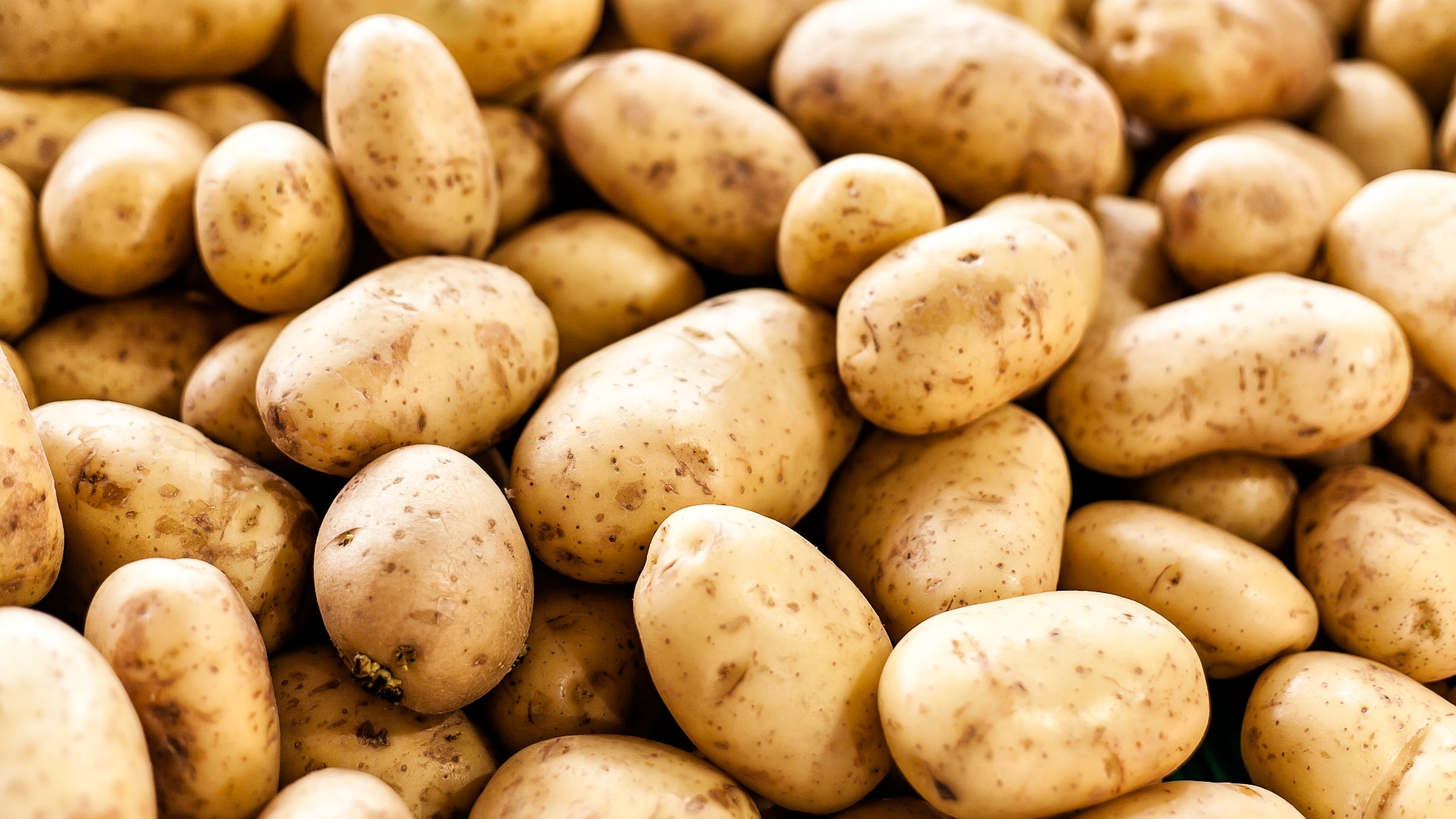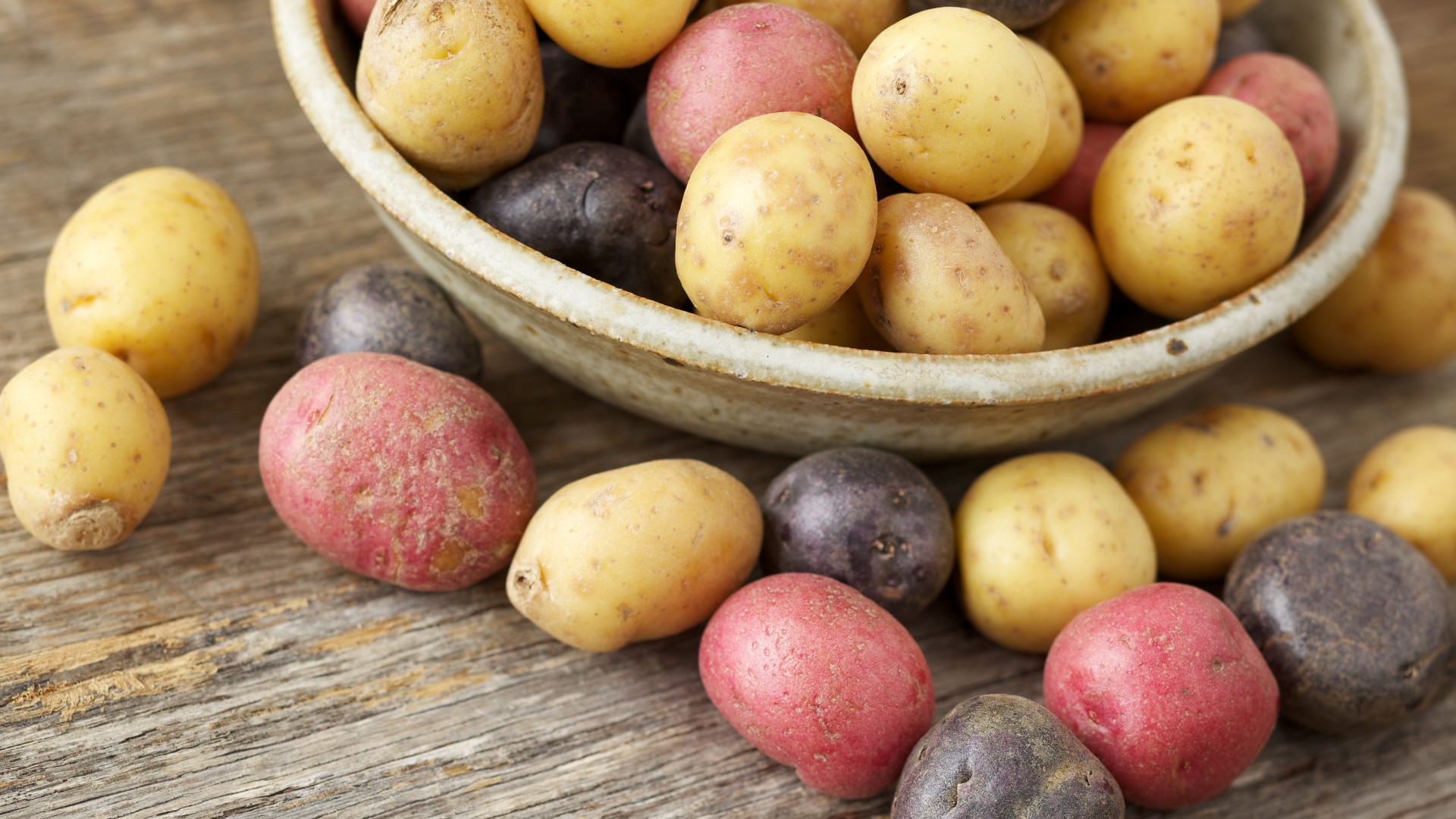Potato nutrition facts & health benefits
Potato nutrition facts show that it can be a very healthy part of a balanced diet if prepared in the right ways.

Potato nutrition facts show that the vegetable can be a very healthy part of a balanced diet when prepared in the right way. However, some of the most popular preparations for potatoes tend to make them increasingly unhealthy by comparison.
Potatoes are the No. 1 vegetable crop in the United States and the fourth most consumed crop in the world, behind rice, wheat and corn, according to the U.S. Department of Agriculture (USDA), followed by tomatoes.
Historically, Americans ate most of their potatoes fresh. Since the 1950s, however, processed potatoes — French fries and hash browns, for example — have grown more popular as the technology to freeze the vegetables has improved. According to the USDA, processed potatoes composed 64 percent of total U.S. potato use during the 2000s, compared to 35 percent in the 1960s. Americans, on average, eat 55 lbs. (35 kilograms) of frozen potatoes per year, 42 lbs. (19 kg) of fresh potatoes, 17 lbs. (8 kg) of potato chips and 14 lbs. (6 kg) of dehydrated potato products.
"Potato has contributed to human diet for thousands of years, first in the Andes of South America and then in the rest of the world. Its contribution to the human diet is affected by cooking, potato intake levels, and the bioavailability of potato nutrients. Generally, the key nutrients found in potatoes including minerals, proteins, and dietary fiber are well retained after cooking. Vitamins C and B6 are significantly reduced after cooking while carotenoids and anthocyanins show high recoveries after cooking due to an improved release of these antioxidants," wrote Gabriela Burgos, Thomas Zum Felde, Christelle Andre and Stan Kubow in "The Potato and Its Contribution to the Human Diet and Health" (Springer, Cham, 2020)
Potatoes are often thought of as a comfort food — richly mashed with butter and sour cream or crisply fried in vegetable oil. But when prepared in these ways, they can lead to weight gain, diabetes and heart disease, according to the Harvard School of Public Health.
In fact, a study published in 2017 in The American Journal of Clinical Nutrition found that people who ate fried potatoes twice a week saw an increased risk of death. The study examined potato intake in 4,400 people between the ages of 45 and 79. By the end of the eight-year study, 236 people had died. Researchers found that those who ate fried potatoes — French fries, hash browns, home fries and more — were more than twice as likely to have died.
The study did not, however, find any correlation between lower volumes of fried potato consumption or non-fried potato consumption and risk of death. This supports the stance of Victoria Jarzabkowski, a nutritionist with the Fitness Institute of Texas at The University of Texas at Austin: potatoes aren’t necessarily bad for you. When cooked the right way — without the addition of butter, cheese or cream — they can even be good for you.
Potatoes are low in calories — a medium-sized baked potato contains only about 110 calories. They are a good source of vitamins C and B6, manganese, phosphorus, niacin and pantothenic acid.
Potato nutrition facts
Here are the nutrition facts for a potato, according to the U.S. Food and Drug Administration, which regulates food labeling through the National Labeling and Education Act:
Potato health benefits

Potatoes are stuffed with phytonutrients, which are organic components of plants that are thought to promote health, according to the USDA. Phytonutrients in potatoes include carotenoids, flavonoids and caffeic acid.
The vitamin C in potatoes acts as an antioxidant. These substances may prevent or delay some types of cell damage, according to the USDA. They may also help with digestion, heart health, blood pressure and even cancer prevention.
Blood pressure
Potatoes may help lower blood pressure for several reasons. Jarzabkowski said that the fiber found in potatoes could help lower cholesterol by binding with cholesterol in the blood. "After it binds, we excrete it.”
Purple potatoes are especially good sources of phytonutrients and antioxidants. A 2012 study published in the Journal of Agriculture and Food Chemistry found that six to eight small purple potatoes twice a day helped lower blood pressure and risk of heart disease and stroke among people who were overweight and suffering from hypertension. Despite the carbohydrates in purple potatoes, the participants did not gain weight.
Potatoes are also a good source of potassium. "All potatoes are potassium rich," Jarzabkowski said. "They have even more potassium than a banana, and a lot of it is found in the [potato's] skin." She noted that the outer potato peel also contains a good deal of fiber. Potassium is a mineral that helps lower blood pressure, according to the U.S. Food and Drug Administration.
Potassium, too, can help lower blood pressure through its actions as a vasodilator (blood vessel widener). Scientists at the Institute for Food Research have discovered that potatoes contain chemicals called kukoamines, which are associated with lowering blood pressure.
Brain functioning and nervous system health
Potatoes' high level of carbohydrates may have some advantages, including helping maintain good levels of glucose in the blood, which is necessary to proper brain functioning. A 1995 study published in the American Journal of Clinical Nutrition found that modest increases in glucose could help enhance learning and memory. Potassium, which encourages the widening of blood vessels, also helps ensure your brain gets enough blood.
Inflammation and arthritis
Some people think potatoes and other members of the nightshade family — such as eggplants, tomatoes and peppers — trigger arthritis flares because they contain the chemical solanine. However, there is limited scientific evidence to support this hypothesis, according to the Arthritis Foundation. The organization suggests that people with arthritis try cutting nightshade vegetables from their diets for two weeks to see if symptoms improve.
Some studies suggest these vegetables may actually help reduce arthritis symptoms, the foundation said. For example, a 2011 study published in The Journal of Nutrition found that potatoes might reduce inflammation.

Digestion
The largest health benefit offered by potatoes is how they can help with digestion due to their high fiber content, Jarzabkowski said. Potatoes' high level of carbohydrates makes them easy to digest, while their fiber-filled skin can help keep you regular.
Heart health
The fiber content in potatoes also make them beneficial for your heart. Jarzabkowski said fiber is associated with clearing cholesterol from blood vessels; vitamins C and B6 help reduce free radicals; and carotenoids help maintain proper heart functioning.
Additionally, B6 plays a crucial role in the methylation process, which, among other things, changes the potentially dangerous molecule homocysteine into methionine, a component in new proteins, according to the Harvard School for Public Health. Too much homocysteine can damage blood vessel walls, and high levels of it are associated with increased risk of heart attack and stroke.
Athletic performance
Jarzabkowski described how potatoes could be a win for athletes. "Potatoes can help restore electrolyte balance," she said. "Sodium and potassium, which are found in potato peels, are two important electrolytes, and athletes lose them in sweat." Electrolytes are necessary for optimum body function, and having too few can cause cramps, as many athletes know.
Cancer and potatoes
A 2017 study published by the Journal of Nutritional Biochemistry found that consuming purple potatoes might reduce the risk of colon cancer. Purple potatoes are high in antioxidants and anti-inflammatory properties that can reduce levels of interleukin-6 or IL-6, a protein linked to cancer cell growth within the colon.
The study looked at groups of pigs on three different diets, one of which was supplemented with purple potatoes. At the end of the study, pigs that ate purple potatoes had levels of IL-6 six times lower than the other groups. While the study has not yet been replicated on humans, researchers anticipate that the results will transfer because a pig’s digestive system is similar to a human’s.
"Potatoes also contain glycoalkaloids, which in high concentrations can be toxic to humans but in low concentrations can have beneficial effects such as inhibition of the growth of cancer cells," wrote Burgos, Zum Felde, Andre and Kubow.
Potato health risks
Dieticians do not recommend a high potato consumption diet because it is almost impossible to get all 20 essential amino acids and 30 vitamins and minerals from one food. A mix of white and sweet potatoes would, however, get you closer than most foods. Nevertheless, your health would suffer from eating nothing but potatoes, said Jarzabkowski.
Blood sugar
Potatoes are fat free, but they are also starchy carbohydrates with little protein. According to Harvard, the carbohydrates in potatoes are the kind that the body digests rapidly and have a high glycemic load (or glycemic index). That is, they cause blood sugar and insulin to surge and then dip. This effect can make people feel hungry again soon after eating, which may lead to overeating. The rapid rise in blood sugar can also lead to increased insulin production. Jarzabkowski said, "The last thing I'd recommend to a diabetic is a potato."
On the other hand, potatoes are also a great source of fiber, Jarzabkowski said, and the fiber content helps you feel fuller longer.
Furthermore, a 2016 study in The American Journal of Clinical Nutrition found that different individuals respond to a food’s glycemic index value in substantially different ways. Therefore, suggested the study, the glycemic index is limited in its usefulness in terms of recommending food choices.
Carbohydrate content
Jarzabkowski recommended that when planning meals, people should remember potatoes' carbohydrate content. "Potatoes should take the place of a grain on the plate. Use it as a carbohydrate rather than as your only vegetable," she said.
Even when prepared in a healthy way, potatoes can present health problems to individuals with obesity or diabetes. They are high in simple carbohydrates, which can lead to weight gain. Jarzabkowski likened the vegetables in this way to white bread.
The Harvard School of Public Health tracked the diet and lifestyle of 120,000 men and women for about 20 years and found that people who increased their consumption of French fries and baked or mashed potatoes gained more weight over time — as much as 3.4 lbs. every four years.
A 2016 study published in The BMJ looked at a large cohort of women and found that those who ate four or more servings of potatoes a week had a higher risk of blood pressure compared to women who ate potatoes less than once a month. The risk held for women who ate baked, boiled, mashed or fried potatoes and for men who ate fried potatoes. Men who ate the equivalent amount of potato chips, however, did not see their risk for higher blood pressure increase. This study further indicates that potatoes may contribute to different health outcomes in different people, perhaps depending on their unique glycemic index reactions. It also emphasizes the importance of potato preparation.
Healthiest ways to cook potatoes

Jarzabkowski emphasized the importance of preparation in potato consumption. "The best way to eat a potato is in its whole, unprocessed form," she said. Baking a potato is the best way to prepare it, as baking, or microwaving, a potato causes the lowest amount of nutrients to be lost, she said.
The next-healthiest way to cook a potato is through steaming, which causes less nutrient loss than boiling. Cooking a peeled potato in this way results in significant nutrient loss, as the water-soluble nutrients leach out into the water.
In a potato, those water-soluble nutrients include B-complex vitamins, vitamin C, potassium and calcium. As much as 80 percent of a potato's vitamin C may go down the drain if you boil the vegetable. The same thing can happen with peeled potatoes that are left to soak, a method used to stop darkening. If you use the water from the potato boil as stock, however, you'll still get some of the nutrients.
However you cook a potato, try to eat the skin. Ounce for ounce, the skin contains more nutrients — including the majority of the vegetable's fiber — than the rest of the potato, Jarzabkowski said.
Are potato eyes poisonous?
If the eyes of a potato are not sprouting, they can be eaten. If they are sprouting, the National Institutes of Health recommends cutting off the eyes and their sprouts before eating the potato.
Potato stems, branches, leaves and fruits are toxic, containing alkaloids such as arsenic, chaconine and solanine. Solanine is "very toxic even in small amounts," according to the NIH.
Poison is also found in green potatoes. The vegetables turn green if they have had too much exposure to light. According to the NIH, you should "never eat potatoes that are spoiled or green below the skin."
Other potato facts
Here are some potato facts, from the U.S. Potato Board and the Idaho Potato Museum:
The word "potato" comes from the Spanish "patata." The nickname "spud" comes from the digging tool used in planting potatoes: "espada" in Spanish, "spyd" in Dutch and "spade" in English. The word eventually became associated with the potato itself.
It is a myth that the word “spud” is an acronym for the Society for the Prevention of an Unwholesome Diet, a supposed activist group that wanted to keep the potato out of Britain in the 19th century.
They are not root vegetables; potatoes are actually the swollen part of the stem of the perennial Solanum tuberosum. This part of the plant is called a tuber, which functions to provide food to the leafy part of the plant.
The "eyes" of potatoes are buds, which will sprout into branches if left alone.
There are thousands of potato varieties, but not all are commercially available. Popular varieties include Russet, red, white, yellow, purple/blue, fingerling and petite.
Idaho, whose license plates bear the slogan “Famous Potatoes,” is the top potato-producing state, but spuds are grown in all 50 U.S. states. Following Idaho are Washington, Wisconsin, North Dakota, Oregon, Colorado, Minnesota, Michigan, Maine and California.
In 2013, there were more than 1 million acres of potatoes planted and harvested, which produced 43.7 billion lbs. (20 billion kg) of the vegetable.
The average American eats about 124 lbs. (56 kg) of potatoes per year; Germans eat about twice as much.
Potatoes were traditionally used to make vodka, although today most vodka is produced using fermented grains such as corn, wheat or rye.
According to Guinness World Records, the largest potato grown was 14 lbs., 14 ounces (4.98 kg).
Additional resources and reading
If you want to learn more about the science behind your food, then find out how calories are calculated.
And can what you eat help to treat depression? Find out by reading this fascinating study and what experts have said in reaction.
Bibliography
- "Potatoes and tomatoes are the most commonly consumed vegetables" U.S. Department of Agriculture
- "The Potato and Its Contribution to the Human Diet and Health" by Gabriela Burgos, Thomas Zum Felde, Christelle Andre and Stan Kubow (Springer, Cham, 2020)
- "The problem with potatoes" Harvard School of Public Health
- "Fried potato consumption is associated with elevated mortality: an 8-y longitudinal cohort study" The American Journal of Clinical Nutrition
- "Role of glucose in regulating the brain and cognition" American Journal of Clinical Nutrition
- "Best Vegetables for Arthritis" Arthritis Foundation
- "Pigmented Potato Consumption Alters Oxidative Stress and Inflammatory Damage in Men" The Journal of Nutrition
- "B Vitamins" Harvard School for Public Health
- "A food-based approach that targets interleukin-6, a key regulator of chronic intestinal inflammation and colon carcinogenesis" Journal of Nutritional Biochemistry
- "Estimating the reliability of glycemic index values and potential sources of methodological and biological variability" The American Journal of Clinical Nutrition
- "Potato intake and incidence of hypertension: results from three prospective US cohort studies" The BMJ
- "Potato plant poisoning - green tubers and sprouts" National Institutes of Health
- "Fun Facts About Potatoes" U.S. Potato Board
- "Potato Facts" Idaho Potato Museum
- "Heaviest potato" Guinness World Records
Sign up for the Live Science daily newsletter now
Get the world’s most fascinating discoveries delivered straight to your inbox.
Jessie Szalay is a contributing writer to FSR Magazine. Prior to writing for Live Science, she was an editor at Living Social. She holds an MFA in nonfiction writing from George Mason University and a bachelor's degree in sociology from Kenyon College.










